Germany is blessed with a wide variety of different castles from diverse time periods. Some of the more interesting are from medieval period. There is a section of the Upper Middle Rhine that has five such castles relatively close to each other. Each are unique and have fascinating back stories. Below is a list of each accompanied with a map and some fun facts about each castle or, in German, burg. There is also a bonus gem at the end . . .
Jump to a specific section.
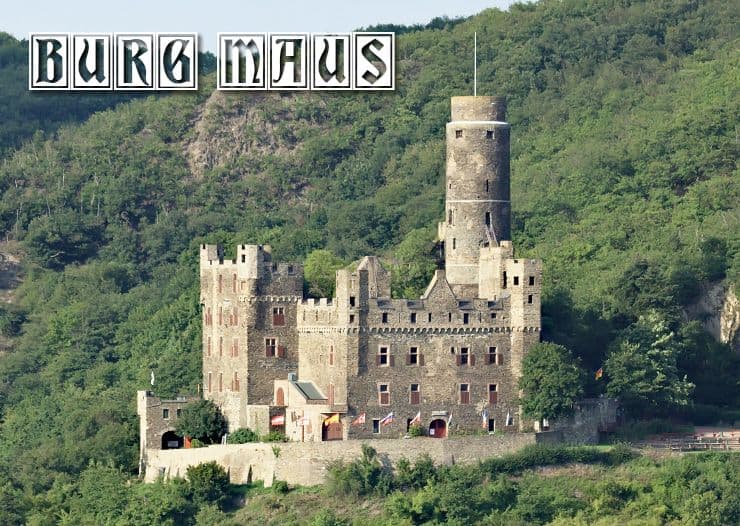
Burg Maus is nestled atop a wooded hill high above the Wellmich section of St. Goarhausen overlooking the Rhine. Its commonly referred to name results from its feud with Burg Katz . . . Cat and Mouse.
LOCATION
Wellmich, Germany
Also known as . . .
Maus Castle
English Pronunciation
ma•os
- It took 30 years to complete the construction of the castle (1356-1386)
- Though it gets its name as an insult from the Counts of Katzenelnbogen (the “mouse” that would be eaten by the “cat” of Burg Katz – see below) , ironically it is Burg Maus that was never destroyed
- The original intended name was Burg Peterseck (or St. Peterseck) and was to be matched by another castle on the opposite bank (though it was never built) to secure its Rhine toll rights and defend itself from the neighboring Burg Katz and Rheinfels (see below)
- Also known as Burg Deuernburg or, among locals as Thurnberg
- Though the castle suffered damage through both neglect and shelling during WWI it was lovingly restored in early 20th century by architect Wilhelm Gärtner
- Today Burg Maus serves as an aviary for falcons, owls and eagles and, from late March to early October, flight demonstrations are staged for visitors
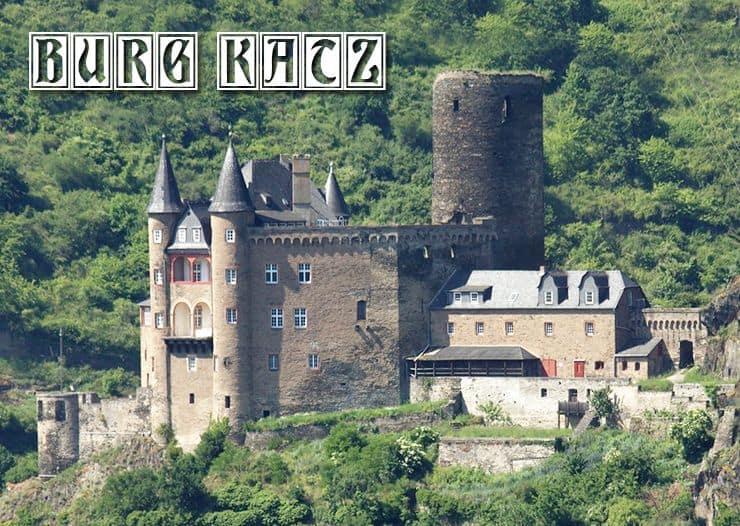
Burg Katz is strategically located facing its nemesis, Burg Maus. While it is not open to the public, Burg Katz can be seen clearly from across the water in the town of St. Goar or at the Dreiburgenblick lookout on the Rheinsteig Trail.
LOCATION
St. Goarshausen, Germany
Also known as . . .
Katz Castle
English Pronunciation
cats
- Built in the late 14th century by the powerful Katzenelnbogen family
- The infamous feud between the counts of Katzenelnbogen and the neighboring Archbishop of Trier led to continuous “cat and mouse games” that led to the rival castles being referred to as Burg Katz and Burg Maus
- Though it suffered much damage during various 17th and 18th century conflicts, the original castle finally was effectively destroyed by Napoleon Bonaparte’s troops, in 1806, during their war with the Prussians
- Also known as Burg Neukatzenelnbogen
- Burg Katz is privately owned and not accessible to the public but can be seen clearly from across the Rhine in St. Goar
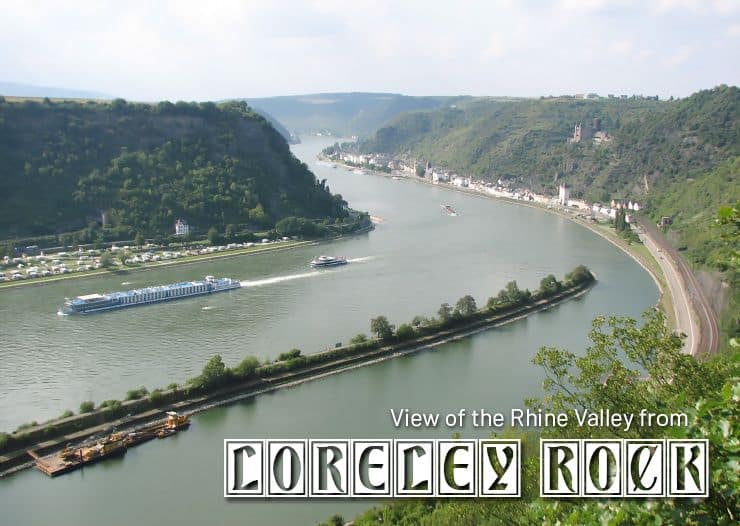
The Loreley is a legendary rock rising above the most treacherous section of the Upper Middle Rhine. Though many songs, poems and myths have been devoted to this very special place, it only became known worldwide through the Loreley song by Heinrich Heine.
LOCATION
St. Goarshausen, Germany
Also known as . . .
The Lorelei
English Pronunciation
laura•lie
- From the lookout you have a truly astounding view of the Rhine River, the village of St. Goar, Burg Rheinfels and Burg Katz
- The lookout point is 433 feet high
- The water below, where the Loreley statue sits, is up to 82 feet deep yet only 371 feet wide making it one of the most dangerous places for large ships
- The legend of Lorelei, similar to the Greek Sirens of Odyssey fame, tells of a nymph who lived high on the hill whose singing lured fisherman to their deaths in the waters below
- The best way to get to, and from, Loreley is by bus (a windy narrow road) from St. Goarhausen
- In case you miss the last bus on the way down (like we did) there are stairs that descend all the way to the water . . . warning, it’s 350 rather steep steps but it’ll get you back to the water’s edge.
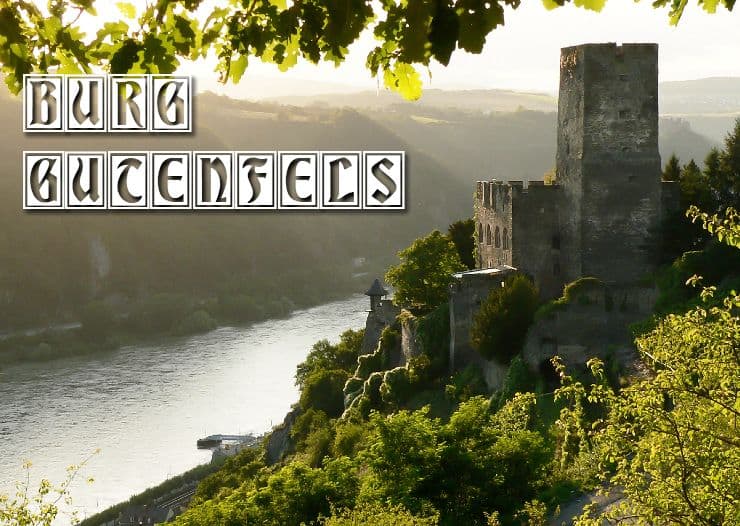
The Caub Castle towers impressively over the vineyards below the quixotic little village of Kaub. The castle got its name Gutenfels (“Good Rock”) after an unsuccessful siege attempt in the early 16th-Century.
LOCATION
Kaub, Germany
Also known as . . .
Caub Castle
English Pronunciation
goo•tin•fells
- Built in 1220 the castle, along with Burg Pfalzgrafenstein (see below) and the town of Kaub on the opposite shore, served as a toll zone for passing vessels
- The castle is one of the most significant examples of the Hohenstaufen house and military construction style along the Rhine
- The wine vineyards on the mountain slopes below the castle get the morning sun which melts any snow quickly and keeps the ground warm
- The occupying Romans built these vineyards for themselves because they worried that the locals might try to poison them
- Today Burg Gutenfels serves as a hotel featuring an amazing banquet hall
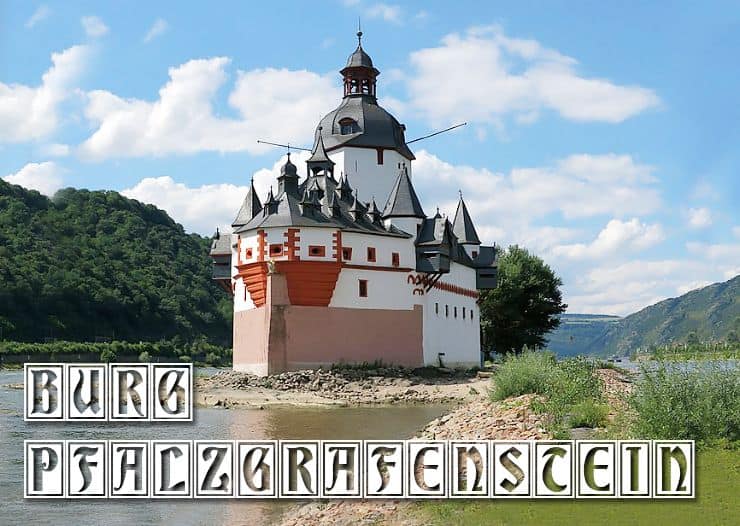
This tiny toll castle has many unique qualities including the fact it literally sits in the Rhine. The great novelist Victor Hugo described Burg Pfalzgrafenstein as “A ship of stone, eternally afloat upon the Rhine, and eternally lying at anchor before the town of Pfalzgrafen.”
LOCATION
Kaub, Germany
Also known as . . .
Pfalz Castle
English Pronunciation
faults•graph•in•stien
- Built in 1327 the original purpose of the castle was to collect tolls from passing vessels
- Failure to pay the toll would land you in the tiny castle’s dungeon
- Tolls continued for 550 years until discontinued by the Prussians in 1867
- Also known as Pfalz Castle, it is the only toll castle on the Rhine whose location is actually in the water
- The central tower, or keep, was erected by King Ludwig of Bavaria in the early 14th century
- Today the castle is a museum accessible via a short ferry ride
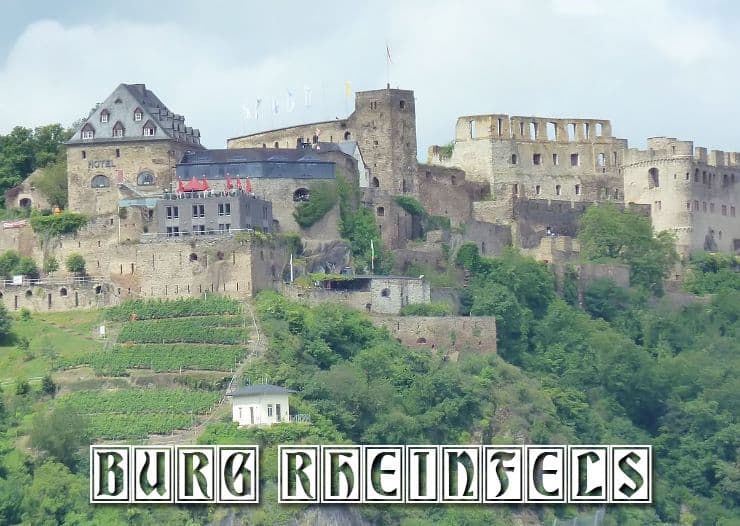
Though a mere spec of its original glory, Burg Rheinfels is still considered the “granddaddy of castle ruins”. At one time it functioned as a complete town when the area was under siege. There is plenty to do and see and the view of the Rhine is unmatched.
LOCATION
St. Goar, Germany
Also known as . . .
Rheinfels Castle
English Pronunciation
ryne•fells
- Built in 1245 the castle served as a protected city for local residents whenever faced with foreign, or domestic, threats
- Despite the fact it is the largest castle overlooking the Rhine, it is estimated to have once been up to five times the size it is today
- Much of this is attributed to the fact that for much of the 19th century its construction was used as a quarry for other building projects
- It was the only Rhineland castle to withstand Louis XIV’s assault during the 17th century including a 28,000 French troop siege in 1692
- Incredible views of the Rhine River as well as Burg Maus, Burg Katz and Loreley
- Burg Rheinfels is accessible either by car or an uphill walk through beautiful local neighborhoods, occasional outdoor restaurants and a vineyard
- Though there are guided tours much of the grounds are walkable including towers, tunnels and expansive echo-chamber rooms below ground-level
BONUS GEM
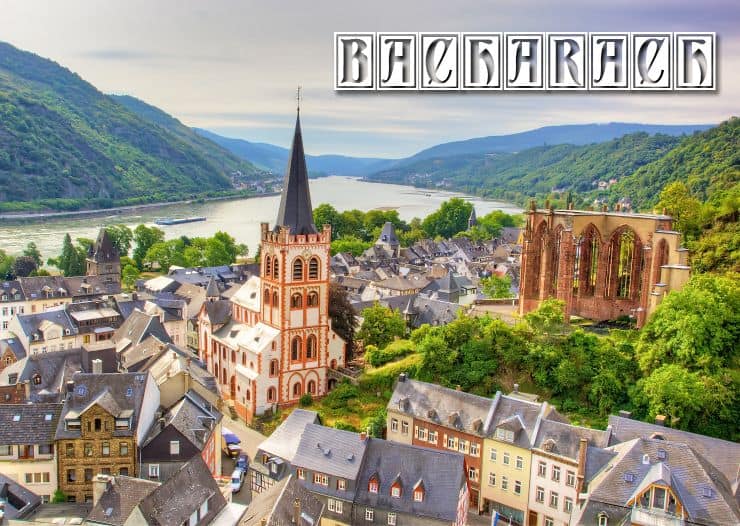
When you hear the expression “quaint little German town” think Bacharach. From its cobblestone lanes lined with half-timbered houses to cottage-size gardens and vineyards featuring world famous Riesling wines, the village is best explored on foot.
LOCATION
Bacharach, Germany
English Pronunciation
bach•a•rach or bah•ha•rah
English pronunciation: all•dis•house
- A centerpiece when you first enter town, this medieval timber-frame house was built in 1368
- One of the few structures not destroyed by fire over the years
- Though the menu is limited it is still worth a visit for the ambience alone
English pronunciation: post•in•turm
- Also known as Post Tower
- The walk to the tower is sprinkled with sweeping and lush vineyards
- Features the very best views looking down onto Bacharach and the Rhine
English pronunciation: verner•cap•el
- Construction of the gothic Werner Chapel began in 1289 but wasn’t completed until 1429
- It was almost completely destroyed in 1689 during the War of the Grand Alliance
- The site features a plaque dedicated to the memory of atrocities against the Jewish population
English pronunciation: stall•eck
- Bacharach’s castle was built in the 12th century but was destroyed in 1689
- During WWII the site was used as a military hospital then an internment camp for Party-loyal German youth
- The current castle is primarily a reconstruction based on excavations and a 1646 engraving by artist Matthäus Merian
- Today it serves as a youth hostel with over 168 beds
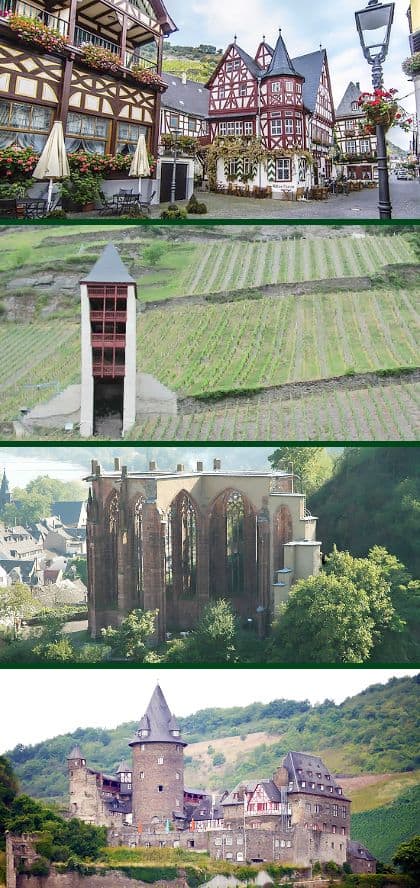
Have you been to any of the Medieval Castles along the Rhine?
We’d love to hear about your adventures so please leave us a Comment below. Thank you and happy travelling!


